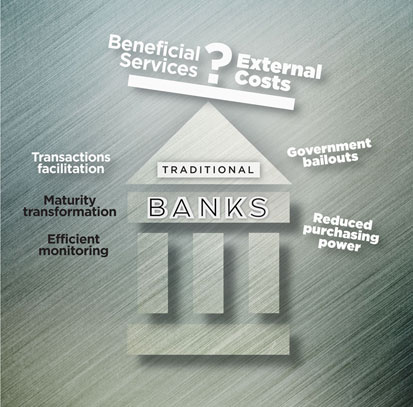Abstract
Banks are prone to panic-induced runs due to their traditional structure of short-term, unconditional liabilities and long-term, illiquid assets. To avoid systemic crises caused by such panics, governments tend to bail out failing banks. Traditional banking systems thus impose external costs. Three major theoretical benefits are often used to justify a banking system that relies on short-term debt despite these costs: (1) maturity transformation, (2) efficient monitoring of bank managers and (3) facilitation of financial transactions. In a previous paper, we argued that the first two justifications, while seemingly compelling, actually suggest financial arrangements very different from our current system. In this paper, we examine the third justification, that a banking system reliant on short-term debt is essential for the facilitation of transactions. We find, in fact, that this reliance is more costly than generally recognized and, moreover, that socially beneficial financial transactions can and should be provided at less cost and risk by both restricting and broadening the payments system. Transactions should be restricted to institutions that continuously mark to market the value of their assets and issue equity claims to owners. Such accounts should also be broadened to include financial vehicles that are readily available, thanks to advances in information and communication technologies, and possibly quite different from current banks.

Introduction1
The financial crisis of 2007-08 and consequent Great Recession generated substantial discussion and debate over future banking regulation. Largely absent, however, has been a careful reexamination of whether the beneficial services provided by traditional banks outweigh the inherent financial fragilities of those banks and their associated costs to society.
Three major benefits are usually said to justify traditional bank reliance on short-term debt, the source of their inherent fragility. In a previous article, we assessed—and found wanting—two of these proposed rationales: (1) the benefit of maturity transformation, or creation of long-term financial assets from shorter-term assets and (2) the benefit of efficient monitoring of bank managers, through appropriate alignment of investor incentives. (See Chari and Phelan 2012a.)
Here we discuss the third justification, that traditional banks are beneficial and necessary because they provide payments services essential to the efficient function of modern economies. We conclude that while this rationale was compelling in an earlier historical era—prior to modern advances in information and communication technology that facilitate transactions of all sorts—the necessary services can now be provided through existing financial vehicles that do not rely on traditionally structured, inherently fragile banks.
We begin by briefly reviewing the structural source of traditional bank fragility and proceed to consideration of the necessity of banks, despite this fragility. We then address the main topic of this paper: the argument that banks as currently structured are necessary because their demand deposits facilitate financial transactions. We conclude that the current structure of banks is unduly costly to society and that essential payments services can, with modern information and communication technologies, be provided with less fragile and more efficient financial institutions.
The inherent fragility of banks
In what sense are banks and similar financial institutions fragile? Our previous paper discusses this question in detail; here we provide a synopsis, referring interested readers to the earlier discussion.
The assets of financial institutions are, by and large, financial assets, and claims on them are primarily financial liabilities. Their financial assets consist mainly of conditional promises to deliver dollars at future dates. These assets, such as home mortgages, are often long term and illiquid. Their financial liabilities consist mostly of a variety of obligations to deliver dollars at particular dates, under certain circumstances. Banks in particular have liabilities that are mostly short term and unconditional, such as demand deposits and certificates of deposit.

This reliance on short-term debt makes banks fragile in that they are particularly vulnerable to the risks of insolvency and the possibility of confidence crises. Since bank assets are much longer term and illiquid than their liabilities and because the value of these assets fluctuates, a bank’s net worth also fluctuates a great deal.
The illiquidity of banks’ assets and the demandable structure of their liabilities thus expose banks to crises of confidence. Since a bank typically will not be able to meet the demands of all depositors within a short period of time should they all choose to withdraw, banks are vulnerable to self-fulfilling panics in which depositors withdraw their funds simply because they believe other depositors will do so. This panic is an entirely rational response even if the bank is solvent (though illiquid).
Governments have a strong incentive to intervene to bail out debt holders of banks in order to prevent the entire financial system from failing. Paradoxically, expectations of such bailouts can increase the incidence and depth of financial crises. Once depositors believe that their deposits will be protected in the event of systemic failure, they have less incentive to monitor bank managers, who, in turn, have increased incentive to take on risk, knowing their failures are implicitly insured by taxpayers.
In this way, expectations of bailouts can lead financial systems to rely excessively—from a social perspective—on short-term debt to fund long-term assets. Fragile banking systems thus impose external costs, and regulation may therefore be socially desirable.
Are banks necessary?
The fragility of the banking system together with the reality that such fragility may well lead to occasional massive bailouts compel us to ask why societies would choose regulatory systems that allow financial institutions to fund illiquid assets whose value can fluctuate rapidly with short-term debt and demand deposits.
One could perhaps argue that banks were necessary prior to the electronic information age because no other forms of financial intermediation were feasible. With the advent of high-speed computers and modern communications, however, alternative financial institutions can provide similar services with far less potential for crises. We discuss such alternatives later in this paper.
We now examine the possible social benefits of a financial system in which illiquid assets with volatile values are funded by demand deposits and short-term debt. This cost-benefit analysis facilitates the design of a better regulatory system for banks, clearly a matter of considerable importance.
The previous paper examined two of the three major theoretical justifications for the reliance of the banking system on short-term debt: (1) demand deposits allow banks to engage in socially useful maturity transformation and (2) demand deposits allow for efficient monitoring of bank managers. This paper considers the third major justification: (3) demand deposits facilitate financial transactions.
To anticipate our conclusion, we believe that while all three justifications are compelling, they point us to a financial system very different from the one currently in place. The first two justifications suggest that it is important to have institutions that finance long-term assets with short-term debt, but we have argued that the assets that are so funded should not have close substitutes in publicly traded markets. In this paper, we will argue two main points regarding the usefulness of banks in facilitating transactions. First, we argue that regardless of technology, the social benefit to using banks to facilitate transactions is lower than the private benefit, thus potentially explaining why the historical ubiquity of bank-facilitated transactions does not imply their efficiency. Second, we argue that the necessity of bank-facilitated transactions is much less obvious than it was a century ago, before advances in information and communication technologies allowed us to create very different institutions than we currently have to facilitate transactions.
Our analysis will suggest a framework for thinking about regulatory policy for institutions that facilitate payments. The economic case for regulating such institutions is convincing, given that the failure of the payments system imposes significant external costs. We argue that institutions that facilitate payments should primarily issue equity-like claims such as those issued by standard mutual funds. Current practice hopelessly conflates these two economic cases into a single institution called “banks” and exposes the economy to unnecessary risks and recurrent costly bailouts.
Assessment of the transactions facilitation view
The most obvious service that banks provide now, and have offered throughout their ubiquitous existence, is payments services. Historically, banks have allowed individuals and firms to pay for goods and services through their provision of bank checks and other widely accepted claims. Therefore, those individuals and firms haven’t had to resort to costly barter or specie trade.
Here, we raise the possibility that banks exist because they provide a privately useful function—the facilitation of transactions in a form that pays households interest—but the social usefulness is less than the private usefulness.
The starting point of our assessment involves the central bank and monetary policy. The central bank creates money, which, for simplicity, we will call “cash.” Cash typically earns no interest. Our first key point is that, to the extent that monetary policy is conducted so as to keep inflation—and thus the (nominal) interest rate—inefficiently high, private agents have strong incentives to develop private payments systems to economize on the use of cash. Interest-bearing demand deposits (checking accounts) at banks are one example of such a private payments system. Because of the interest received in such accounts, households and firms will find it advantageous to switch from cash to these private deposits as their means of payment. Clearly, then, there would be private benefits to the introduction of payments systems like checking accounts.
But do these private benefits imply equivalent social benefits? If one household’s use of demand deposits imposed no costs on other households, the answer would be yes. But if use of such demand deposits does indeed impose costs on other households, the net social benefit of demand deposits will be lower and can, in fact, be negative. In the appendix, we present an example economy where these net social benefits from demand deposits are indeed negative, even though each household finds it in its interest to use them (since the private benefits are positive). In Chari and Phelan (2012b), we present a more general model where the net social benefits from interest-bearing means of payments can be either positive or negative, but are nevertheless always less than the private benefits.
The reason one household’s use of demand deposits imposes costs on other households is as follows: Introducing bank-provided payments leads to an expansion of the “means-of-payment” supply, now defined to include both cash and the amount of demand deposits. This higher means-of-payment supply leads to higher prices in the aggregate economy, which reduces the purchasing power of other households’ deposits and cash—but individual firms or households do not take this into account when they choose to use demand deposits over cash. This pecuniary externality (that is, an external cost imposed through prices rather than real resources) can cause households to use deposits instead of cash in cases where they wouldn’t, had they internalized this cost imposed on other households, and this externality implies that net social benefits of demand deposits are lower than net private benefits.
With net private benefits of banking exceeding net social benefits, it is clear that the banking system will be inefficiently large. In the model presented in the appendix, because the net social benefits are negative, not only is the banking system inefficiently large, the optimal size of banks is zero.
The model in the appendix is but a simple example, and the implications from it seem unrealistic. However, we would argue that recent developments in communication technologies and financial innovations may in fact make the model’s implications more than just a hypothetical scenario.
Historically, communication costs and limited development of financial markets have led to the use of systems in which only a fraction of a household’s financial wealth could be used for payments. With improvements in communication and financial markets, however, we can conceive of a world in which each individual can instantaneously access all of his or her financial wealth to make payments. We can also imagine a world in which settlement of transactions is instantaneous. In this world, cash becomes unnecessary, and precisely because cash is unnecessary, there is little or no need for payments systems that arise from the need to economize on cash, that is, arise because monetary policy is setting the inflation rate too high.
In the 1800s, it would have been inconceivable to pay for groceries, for example, by using a debit card associated with one’s mutual fund or stock portfolio (and in doing so, stocks were immediately sold, and the grocery received its settlement while the shopper was still at the counter). But today, this scenario is not far-fetched. In a world with virtually costless communication, banks as specialized providers of transactions services would simply be obsolete. These observations lead us to conclude that the actual importance of banks in the payments system is likely small today and will likely become even smaller in the near future. This is the third and final key point in our assessment of the transactions facilitation view.
What should “banks” look like, if not the traditional but fragile demand-deposit bank? As mentioned in the introduction, alternative financial institutions can provide similar services to the transactions facilitation services that traditional banks offer with far less potential for crises. One such example is the open-end mutual fund. These funds do not owe their shareholders a fixed dollar amount, but instead only the value of their percentage of the fund on the day the shareholder wishes to withdraw. If an unexpected surge of withdrawals occurs, the fund simply sells a sufficient quantity of the fund’s assets and gives the proceeds to the withdrawing shareholders. After this, the remaining shareholders still hold exactly the same assets per share as before. No shareholder gains by being earlier in line than other shareholders. Therefore, a belief that a run will occur cannot cause a run for a mutual fund—the self-fulfilling nature of runs that afflicts banks with demand deposits is thus avoided.
MMMFs are not open-end mutual funds
One modern financial institution, the money market mutual fund (MMMF), which appears to resemble an open-end mutual fund as described above, is quite different in practice. MMMFs were perceived as promising one dollar for each share held as opposed to a claim to a pro rata share of the fund’s assets. MMMFs in this sense resemble banks more closely than they do ordinary mutual funds.
During the financial crisis of 2007-08, there were no runs on ordinary mutual funds, including mutual funds invested in assets very similar to the assets held by MMMFs, nor were there any concerns by policymakers about runs on such ordinary mutual funds. In sharp contrast, after the fall of Lehman Brothers in September 2008, the Reserve MMMF was subject to significant withdrawals. It suspended withdrawals from the fund and eventually returned 98 cents on the dollar to shareholders. Policymakers instituted a variety of policies, including a program to insure the shareholders of all MMMFs.
Implications for policy
Banks have been a durable part of the economic landscape for many centuries, and economic theory does explain why it might be efficient to set up institutions that fund long-term assets with short-term debt. Theory also illustrates that it might be optimal for private agents, but undesirable for society at large, to establish such institutions. These competing lessons from economic theory also provide guidance for regulation of such institutions.
As discussed in the earlier paper, both the
maturity transformation and the efficient monitoring views suggest that, given the costs imposed by crises and attendant bailouts, it may be desirable to allow financial institutions to issue short-term debt only if their assets do not have close publicly traded substitutes. Further, to minimize the incentive of governments to bail out institutions if a crisis occurs, such institutions should be separated from the payments system.
Any regulatory system must also take seriously the central role that banks have long played in the payments system. We have argued that this role may well be an artifact of a bygone era. Advances in information and communication technology make it feasible to access a wide array of assets, from stocks in public firms to portfolios of home equity loans, to undertake transactions. We have also argued that payments systems that require the use of demand deposits expose the economy to confidence crises and that it is possible to devise payments systems that do not require the use of debt-like claims, but instead use equity-like claims for transactions purposes.
These considerations suggest that the payments system should be both restricted and broadened. Transactions accounts should be restricted to institutions that mark the value of their assets to market continuously and that issue mutual-fund-like equity claims to owners. Such accounts should be broadened to institutions that are possibly very different from modern-day banks to include institutions such as stock and bond mutual fund companies.
We emphasize that the money market mutual fund as currently structured resembles a bank more than it does a mutual fund and therefore should not be allowed to issue transactions accounts. So, for example, Vanguard’s money market mutual fund (as currently structured) would no longer be allowed to serve as a transactions account, but Vanguard’s 500 Index Fund would.
The framework for regulatory policy implied by our analysis would lead to a banking system that is radically different from the one we currently have. Institutions that issue large amounts of short-term debt relative to their assets would be regulated and required to hold relatively little of their assets in publicly traded securities. The liabilities of such institutions would not serve as means of payment. The payments system would consist of institutions that issue equity claims.
Economic theory tells us that we do need banks. Theory also points us to constructive ways in which we can reform the financial system to make it more efficient and to ensure that crises that affect particular financial institutions do not spill over into the rest of the economy.
Endnotes
1 The authors thank Narayana Kocherlakota, Dick Todd and Kei-Mu Yi for useful comments and Doug Clement for editorial assistance. V. V. Chari thanks the National Science Foundation for supporting the research that led to this paper.
References
Chari, V. V., and Christopher Phelan. 2012a. What Assets Should Banks Be Allowed to Hold? Economic Policy Paper 12-3, (May) Federal Reserve Bank of Minneapolis.
Chari, V. V., and Christopher Phelan. 2012b. On the Social Usefulness of Fractional Reserve Banking. Working paper. University of Minnesota.






